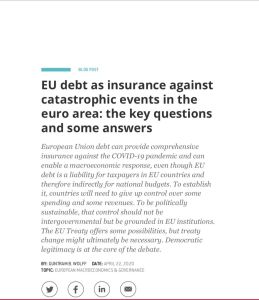
Guntram B. Wolff
EU Debt as Insurance Against Catastrophic Events in the Euro Area
The Key Questions and Some Answers
Bruegel, 2020
What's inside?
European Union debt could help member states handle the costs of the coronavirus pandemic.
Recommendation
Policy makers in the European Union’s member countries must walk a fine line between inaction and misdirection in their search for a way to combat the economic malaise wrought by the coronavirus. EU-issued debt could serve as an effective, temporary backstop to bring some degree of relief to the region’s economies. As this astute analysis from economist Guntram B. Wolff reveals, this insurance instrument should derive from EU institutions rather than from national governments. Such an approach would be more politically viable, no small feat in the rough-and-tumble obstacle course that is the European Union.
Take-Aways
- The issuance of EU debt could provide a viable insurance mechanism by which to manage the sharp economic declines that the coronavirus has caused member states.
- The use of debt to restore economic well-being to countries raises a host of issues and challenges.
- The way forward for the region is a temporary support system with legal underpinnings and controls.
Summary
The issuance of EU debt could provide a viable insurance mechanism by which to manage the sharp economic declines that the coronavirus has caused member states.
European leaders are scrambling for ways to alleviate the region’s severe economic woes from fighting the COVID-19 pandemic. A potential tool could be EU debt, even if the euro area’s taxpayers and national budgets would be on the hook.
““Providing insurance against catastrophic shocks increases the stability of the system. And the stability of the system is in the interest of all members of the system. EU debt is highly desirable and necessary to preserve the integrity of the single market.” ”
The use of supranational debt would necessarily be a collaborative effort, requiring member states to cede control over income and expenses to a certain degree. With some work, the pursuit of this solution through the EU Treaty could be a possible way to restore stability to the macroeconomy.
The use of debt to restore economic well-being raises a host of issues and challenges.
The option of EU member countries directly borrowing, with European Central Bank (ECB) support, could prove self-defeating. While the ECB’s pandemic emergency purchase program (a large-scale bond buying arrangement) did raise liquidity for member nations and reduced fiscal stress, these bond purchases of individual member states’ debt are subject to political and legal restrictions so as not to breach EU Treaty rules. Additionally, some countries’ sovereign credit could command higher and possibly unsustainable yields. Individual nations could borrow too much or too little, and give different treatment to their domiciled companies. That approach could disrupt the European Single Market and cause political strife.
““Overall, EU-based programs establish EU-level control and EU-level legitimacy that comes from the European Parliament and member states through the European Council and the Council of the European Union.” ”
EU debt raises other issues, but it has upsides. Mutualized debt would be a liability for each member state, adding a line item in its budget. And the article of the EU Treaty that allows direct EU support to nations in “exceptional circumstances” might have to be amended to allow large-scale EU loans. But the change – a one-time arrangement to address COVID-19 economic losses without establishing “a permanent fiscal union” – could be politically feasible. EU-level surveillance would also mitigate the risk of moral hazard. Having member countries guarantee large amounts of shared debt under the auspices of the European Commission would be akin to allocating monies from the EU budget, which is credible due to its history and legal foundations.
The way forward for the region is a temporary support system with legal underpinnings and controls.
EU members will need to come together to provide for a provisional borrowing solution that respects treaty restrictions. Such an approach would provide for the proper oversight and accountability of a process that integrates joint borrowing and control over income and expenses. Existing institutions, such as the European Parliament and the European Court of Auditors, could facilitate such an arrangement.
About the Author
Guntram B. Wolff is the director of Bruegel, a European think tank.
This document is restricted to personal use only.
My Highlights
Did you like this summary?
Read the articleThis summary has been shared with you by getAbstract.
We find, rate and summarize relevant knowledge to help people make better decisions in business and in their private lives.
Already a customer? Log in here.
























Comment on this summary